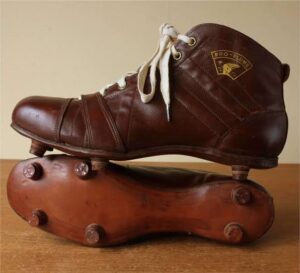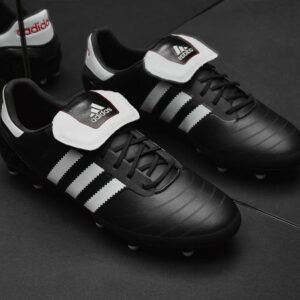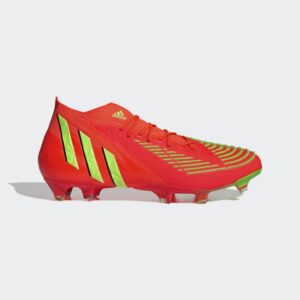Football Boot Evolution: From Leather to High-Tech
Football has always been more than just a game — it’s a global culture, a unifying passion, and a multi-billion-dollar industry. Among the many elements that have shaped the sport, few pieces of equipment have undergone as much transformation as the football boot. The story of football boot evolution is a journey from heavy, ankle-high leather shoes to today’s lightweight, high-tech performance enhancers.
In this article, we’ll trace the fascinating history of football boots, explore key innovations that shaped the game, and look ahead at what the future holds for this essential gear.
A Brief Introduction to Football Boot Evolution
Before the high-speed sprints of Kylian Mbappé or the pinpoint passes of Kevin De Bruyne, players wore boots that were closer to workwear than sportswear. Over time, advances in materials, design, and technology transformed boots into precision-engineered tools that impact how the game is played.
This football boot evolution reflects more than just fashion — it highlights how sports science and player needs have driven innovation over more than a century.
The Origins: Heavy Leather and Function Over Flair (1800s)

In the early days of football during the 19th century, there was no such thing as a dedicated football boot. Players often wore work boots or modified shoes designed for industrial labor.
-
Design: Thick, rigid leather that extended above the ankle.
-
Weight: Nearly 500 grams each, even heavier when wet.
-
Purpose: Purely protection — dribbling and passing were secondary.
These boots had little flexibility, minimal comfort, and no consideration for performance. They symbolized the rugged, physical style of early football.
1950s: The Shift Toward Performance

The 1950s marked a turning point in football boot design. The most notable development came during the 1954 FIFA World Cup, when screw-in studs made their debut.
-
Adidas innovation: Introduced boots with replaceable studs for different pitch conditions.
-
Lower cuts: Boots no longer extended above the ankle, allowing players greater mobility.
-
Focus on agility: Speed and ball control began to matter more than just protection.
This period marked the first step toward boots being viewed as performance-enhancing tools.
1970s–1980s: The Rise of Iconic Football Boots

The late 20th century saw the rise of football boots as both sporting equipment and cultural icons.
-
Adidas Copa Mundial (1979): Still one of the most famous boots ever made, worn by legends like Franz Beckenbauer.
-
Puma King: Popular with Pelé and Diego Maradona, symbolizing flair and control.
-
Nike’s Entry (1970s): The American sportswear giant entered football, sparking fierce competition in innovation.
Designs became sleeker, softer, and better suited to different playing styles — defenders, midfielders, and strikers all began to see tailored designs.
1990s: Lightweight Revolution and Bold Colors

The 1990s represented a cultural and technological explosion in football boot design.
-
Synthetic materials: Replaced heavy leather, reducing weight significantly.
-
Lightweight designs: Some boots weighed under 300 grams, giving strikers a major advantage.
-
Color revolution: Gone were the days of all-black boots — players now wore neon, metallic, and patterned designs.
-
Star power: David Beckham’s Adidas Predator and Ronaldo’s Nike Mercurial became symbols of a generation.
Boots became part of a player’s personality and marketing identity, influencing fans and young players around the world.
2000s to Present: High-Tech Masterpieces

Modern football boots are engineered with cutting-edge technology. They’re designed not just for comfort, but to enhance every aspect of a player’s performance.
Key Innovations:
-
Knitted uppers: Provide a sock-like fit for comfort and control.
-
3D textures and grip zones: Help with precision passing and ball handling.
-
Carbon fiber plates: Enhance speed and acceleration.
-
Lightweight builds: Some boots weigh under 200 grams, maximizing agility.
-
Customization: Brands now offer boots tailored to individual foot shapes and playing styles.
Nike’s Mercurial Superfly and Adidas’ Predator Mutator are prime examples of how far boot technology has come.
The Future of Football Boots

The story of football boot evolution is far from over. Looking ahead, we can expect even more exciting innovations:
-
Smart boots: Equipped with sensors to track sprint speed, distance, and ball strikes.
-
Eco-friendly materials: Brands are shifting toward sustainable and recycled components.
-
AI-driven design: Boots customized by artificial intelligence to match a player’s unique movements.
-
Enhanced biomechanics: Designs that reduce injuries while maximizing explosive power.
The football boot of the future may not just improve performance — it may also integrate directly into coaching, analytics, and fan engagement.
Conclusion: The Legacy of Football Boot Evolution
From heavy leather work boots to sleek, high-tech marvels, the football boot evolution reflects the transformation of football itself. What started as protection for players’ feet has become a crucial piece of technology that can influence the outcome of a match.
As the game continues to evolve, one thing is certain: the football boot will remain at the heart of innovation, style, and performance in the beautiful game.
FAQs About Football Boots
1. Why were early football boots so heavy?
Early boots were made of thick leather for protection, not performance. Once wet, they became even heavier, sometimes doubling in weight.
2. What was the first football boot with screw-in studs?
Adidas introduced the first boots with screw-in studs in the 1954 World Cup, revolutionizing grip and adaptability.
3. Why do modern football boots have knitted uppers?
Knitted uppers provide a snug, sock-like fit that improves comfort and ball control, reducing the gap between foot and boot.
4. Are leather boots still used today?
Yes, but they’re less common. Some players still prefer kangaroo leather boots for their comfort and natural feel.
5. What’s next for football boots?
The future points to smart boots with sensors, eco-friendly materials, and AI-driven personalization.









